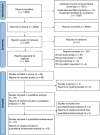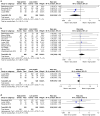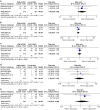High protein intake on later outcomes in preterm children: a systematic review and meta-analysis
- PMID: 38858504
- PMCID: PMC11798874
- DOI: 10.1038/s41390-024-03296-z
High protein intake on later outcomes in preterm children: a systematic review and meta-analysis
Erratum in
-
Correction: High protein intake on later outcomes in preterm children: a systematic review and meta-analysis.Pediatr Res. 2025 Feb;97(2):863-864. doi: 10.1038/s41390-024-03592-8. Pediatr Res. 2025. PMID: 39528748 Free PMC article. No abstract available.
Abstract
Background: Appropriate protein intake is crucial for growth and development in children born preterm. We assessed the effects of high (HP) versus low protein (LP) intake on neurodevelopment, growth, and biochemical anomalies in these children.
Methods: Randomised and quasi-randomised trials providing protein to children born preterm (<37 completed weeks of gestation) were searched following PRISMA guideline in three databases and four registers (PROSPERO registration CRD42022325659). Random-effects model was used for assessing the effects of HP (≥3.5 g/kg/d) vs. LP (<3.5 g/kg/d).
Results: Data from forty-four studies (n = 5338) showed HP might slightly reduce the chance of survival without neurodisability at ≥12 months (four studies, 1109 children, relative risk [RR] 0.95 [95% CI 0.90, 1.01]; P = 0.13; low certainty evidence) and might increase risk of cognitive impairment at toddler age (two studies; 436 children; RR 1.36 [0.89, 2.09]; P = 0.16; low certainty evidence). At discharge or 36 weeks, HP intake might result in higher weight and greater head circumference z-scores. HP intake probably increased the risk of hypophosphatemia, hypercalcemia, refeeding syndrome and high blood urea, but reduced risk of hyperglycaemia.
Conclusions: HP intake for children born preterm may be harmful for neonatal metabolism and later neurodisability and has few short-term benefits for growth.
Impact statement: Planned high protein intake after birth for infants born preterm might be harmful for survival, neurodisability and metabolism during infancy and did not improve growth after the neonatal period. Protein intake ≥3.5 g/kg/d should not be recommended for children born preterm.
© 2024. The Author(s).
Conflict of interest statement
Competing interests: The authors declare no competing interests.
Figures




Similar articles
-
Comparison of different protein concentrations of human milk fortifier for promoting growth and neurological development in preterm infants.Cochrane Database Syst Rev. 2020 Nov 20;11(11):CD007090. doi: 10.1002/14651858.CD007090.pub2. Cochrane Database Syst Rev. 2020. PMID: 33215474 Free PMC article.
-
Individualized versus standard diet fortification for growth and development in preterm infants receiving human milk.Cochrane Database Syst Rev. 2020 Nov 23;11(11):CD013465. doi: 10.1002/14651858.CD013465.pub2. Cochrane Database Syst Rev. 2020. PMID: 33226632 Free PMC article.
-
High versus standard volume enteral feeds to promote growth in preterm or low birth weight infants.Cochrane Database Syst Rev. 2021 Mar 9;3(3):CD012413. doi: 10.1002/14651858.CD012413.pub3. Cochrane Database Syst Rev. 2021. PMID: 33733486 Free PMC article.
-
Impact of macronutrient supplements for children born preterm or small for gestational age on developmental and metabolic outcomes: A systematic review and meta-analysis.PLoS Med. 2019 Oct 30;16(10):e1002952. doi: 10.1371/journal.pmed.1002952. eCollection 2019 Oct. PLoS Med. 2019. PMID: 31665140 Free PMC article.
-
High versus low medium chain triglyceride content of formula for promoting short-term growth of preterm infants.Cochrane Database Syst Rev. 2021 Feb 23;2(2):CD002777. doi: 10.1002/14651858.CD002777.pub2. Cochrane Database Syst Rev. 2021. PMID: 33620090 Free PMC article.
Cited by
-
Protein intakes for preterm infants, and the need for a multi-nutrient holistic approach.Pediatr Res. 2025 Jan;97(1):8-10. doi: 10.1038/s41390-024-03453-4. Epub 2024 Aug 10. Pediatr Res. 2025. PMID: 39122823 Free PMC article. No abstract available.
-
Formula protein versus human milk protein and the effects on growth in preterm born infants.Curr Opin Clin Nutr Metab Care. 2025 Jan 1;28(1):33-38. doi: 10.1097/MCO.0000000000001084. Epub 2024 Nov 11. Curr Opin Clin Nutr Metab Care. 2025. PMID: 39659212 Free PMC article. Review.
-
Nutrition and growth in preterm babies - are we measuring the right thing?Pediatr Res. 2025 Jul 11. doi: 10.1038/s41390-025-04270-z. Online ahead of print. Pediatr Res. 2025. PMID: 40646284 No abstract available.
-
Improving growth in preterm infants through nutrition: a practical overview.Front Nutr. 2024 Sep 10;11:1449022. doi: 10.3389/fnut.2024.1449022. eCollection 2024. Front Nutr. 2024. PMID: 39318385 Free PMC article. Review.
-
Recommended nutrition for preterm infants-on track, but more research is needed.Pediatr Res. 2025 Apr 6. doi: 10.1038/s41390-025-04062-5. Online ahead of print. Pediatr Res. 2025. PMID: 40189634
References
-
- Griffin, I. J. Perinatal Growth and Nutrition (CRC Press, 2014).
-
- Huang, Y.-T., Lin, H.-Y., Wang, C.-H., Su, B.-H. & Lin, C.-C. Association of preterm birth and small for gestational age with metabolic outcomes in children and adolescents: a population-based cohort study from Taiwan. Pediatr. Neonatol.59, 147–153 (2018). - PubMed
Publication types
MeSH terms
Substances
LinkOut - more resources
Full Text Sources
Medical
Research Materials
Miscellaneous

